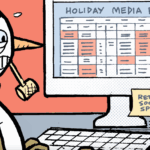 “On TV And Video” is a column exploring opportunities and challenges in advanced TV and video.
“On TV And Video” is a column exploring opportunities and challenges in advanced TV and video.
Today’s column is written by Mark Zagorski, CEO at Telaria. Hear him speak at the upcoming Industry Preview conference, January 17-18 in NYC.
Sure, over-the-top (OTT) subscription content is all the rage. It’s buzzy, still new and the market is bullish on it. Just look at Netflix’s stock price – it’s getting a lot of attention. For now.
But tomorrow’s connected TV (CTV), which sits within the OTT ecosystem and refers to content delivered to a television with internet connectivity, will look a lot like the traditional TV of today, as the next big wave of content will be majority ad-supported, not subscription-based. The reasons for this are myriad, and they are coalescing to form a huge tailwind that will power the future of connected TV.
It all starts with consumers and their insatiable demand for premium video content. Successive generations increasingly consider “watching TV” as an on-demand, on-any-device experience. Digital delivery of premium, long-form content anywhere is not just a consideration for consumers anymore, it’s expected.
This creates a virtuous cycle. With the growing demand for premium content, publishers and content creators have compelling incentives to create ever more premium video content. Between Hulu, Amazon and Netflix alone, $13 billion will be spent on content creation in 2018, a staggering number when you consider the sector didn’t exist 10 years ago.
New, OTT-only content networks such as PlutoTV and Young Hollywood are sprouting up on smart TVs everywhere. Private equity and VC money are looking to OTT for hyperbolic growth, adding fuel to the content fire, and consumers are lapping it up.
This cycle does have a hiccup, though. The early subscription-based models worked when consumers paid for two to three premium packages altogether. Though they are still hungry for content, they are rapidly starting to suffer from subscription fatigue. They can’t stomach 10 different subscription services that end up being more expensive than cable and less searchable than YouTube. Nearly a quarter of consumers feel they have too many entertainment-based subscriptions already, according to LEK Consulting.
Enter a time-tested cure: advertisers.
Advertisers are in a never-ending pursuit for a moment of attention from their target audiences, and they now can achieve this in an efficient, addressable way. The CTV world of premium, professionally produced, 100% viewable and brand-safe content becomes a no-brainer for brands large and small.
With a broad spectrum of premium content offerings at multiple reach and price levels, plus the unique capability for data-driven targeting, CTV brings together the best of the digital and linear TV advertising worlds. And, with the friction-free buying tools of the programmatic world already deeply embedded in digital video workflows, it has become a go-to for brands seeking to escape the dark alleys of short-form, long-tail video exchanges.
These whirlwind forces of consumer demand, producer supply and an eager marketing community mean that advertising will play the decisive role in this next era of TV, just as it did the first time around. We are already seeing evidence of this with the news this week of Amazon looking to develop a free ad-supported version of Prime video. Advertising, not subscriptions, will drive the broad and universal adoption of CTV among consumers and the funding to support content creators.
For this iteration of television, however, we must avoid mistakes made in digital advertising and linear TV.
Programmatic technologies that revolutionized digital display advertising delivered both positive (efficiency, targeting) and negative (lack of transparency, fraud) disruptions that we must be vigilant about addressing. Overzealous linear TV programmers jammed in too many redundant, competitive ads, creating a terrible consumer experience and frustrating advertisers. Transparent business models and partnerships can attack the former, and technology that delivers ads efficiently and relevantly can deal with the latter. We have the experience, talent and tools not to mess this up.
The stakes are huge. If you can envision a day not too far in the future when all TV is addressable and ad-supported, the market has the potential to reach $235 billion, based on aggregated figures from PwC and Digital TV Research. Last week, as Roku’s stock soared by more than 50% in a day, the market seems to be saying the same thing: CTV advertising will be big, and it’s digital’s game to win – or lose.
Follow Telaria (@TelariaVideo) and AdExchanger (@adexchanger).










